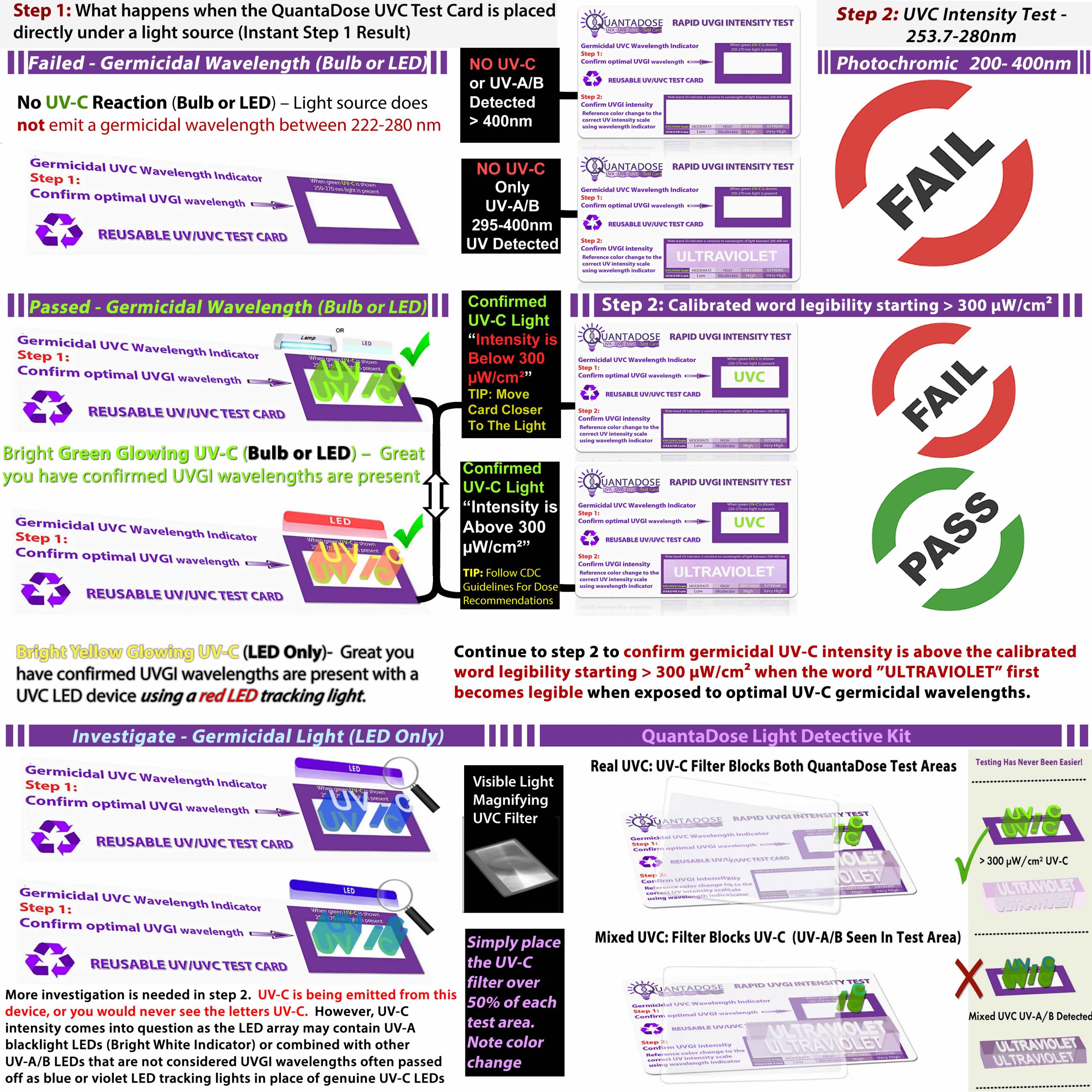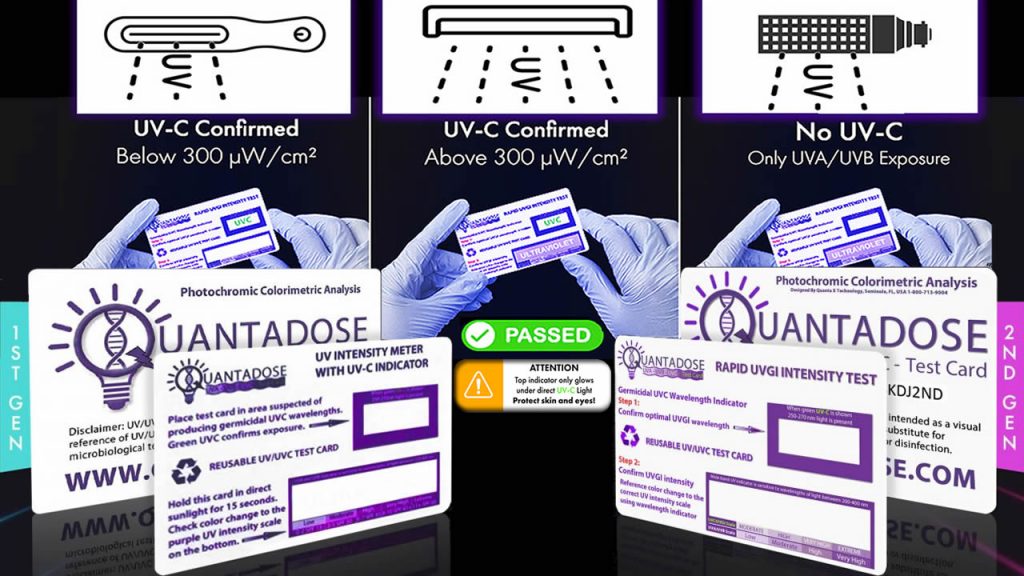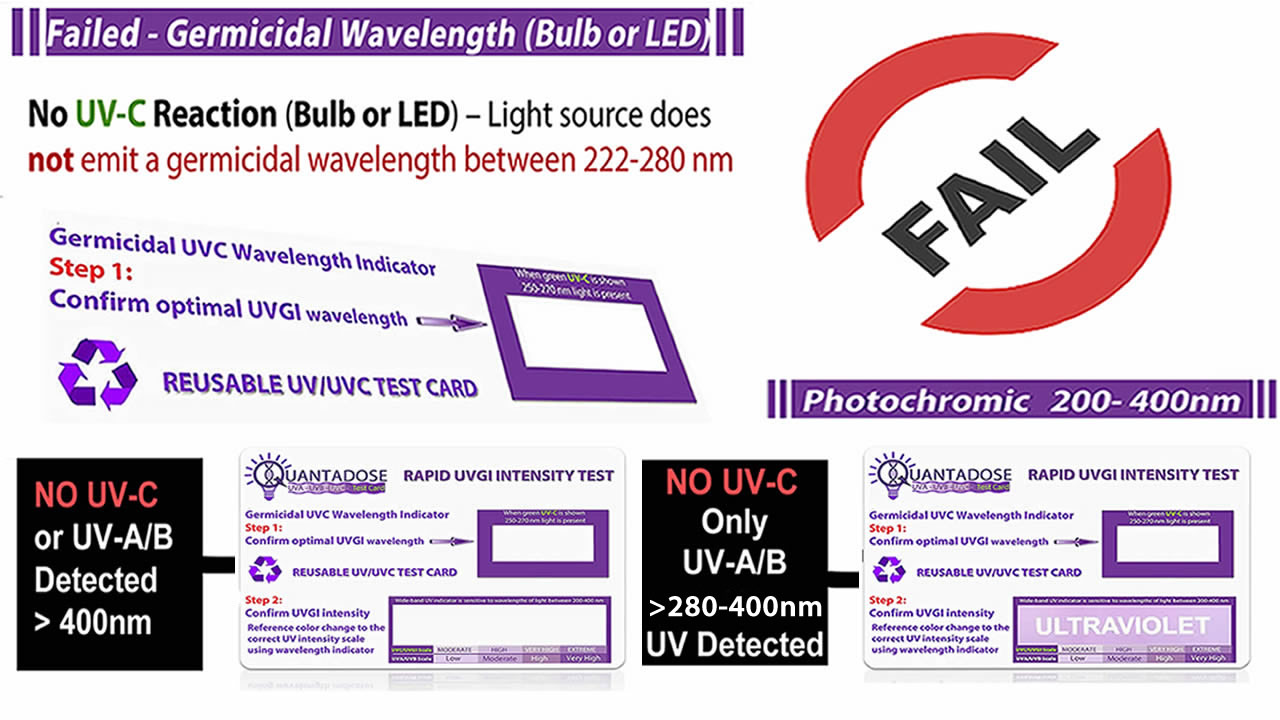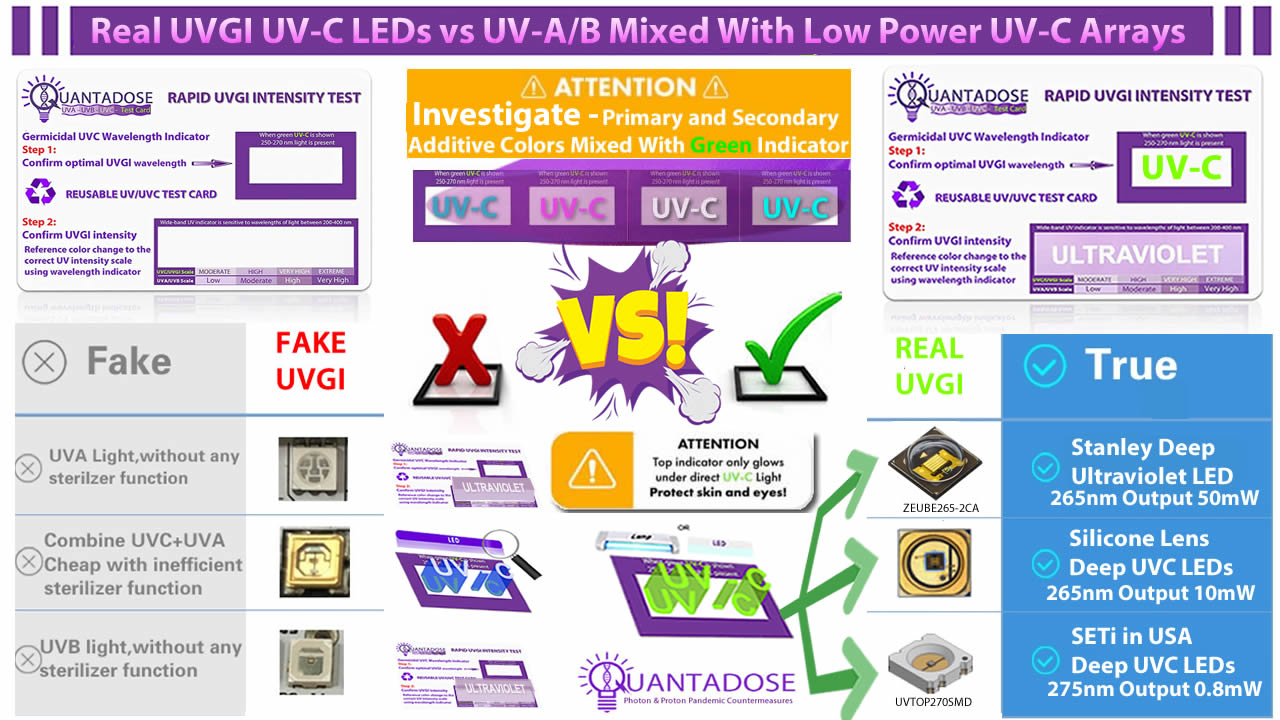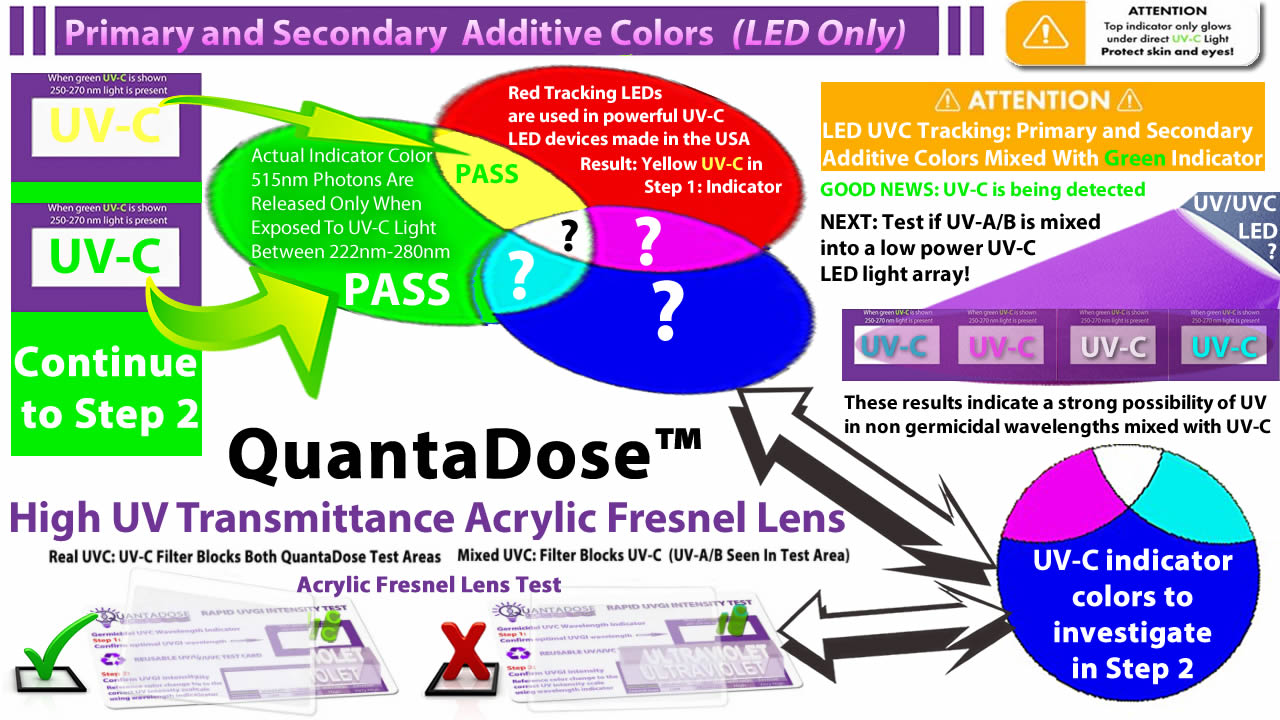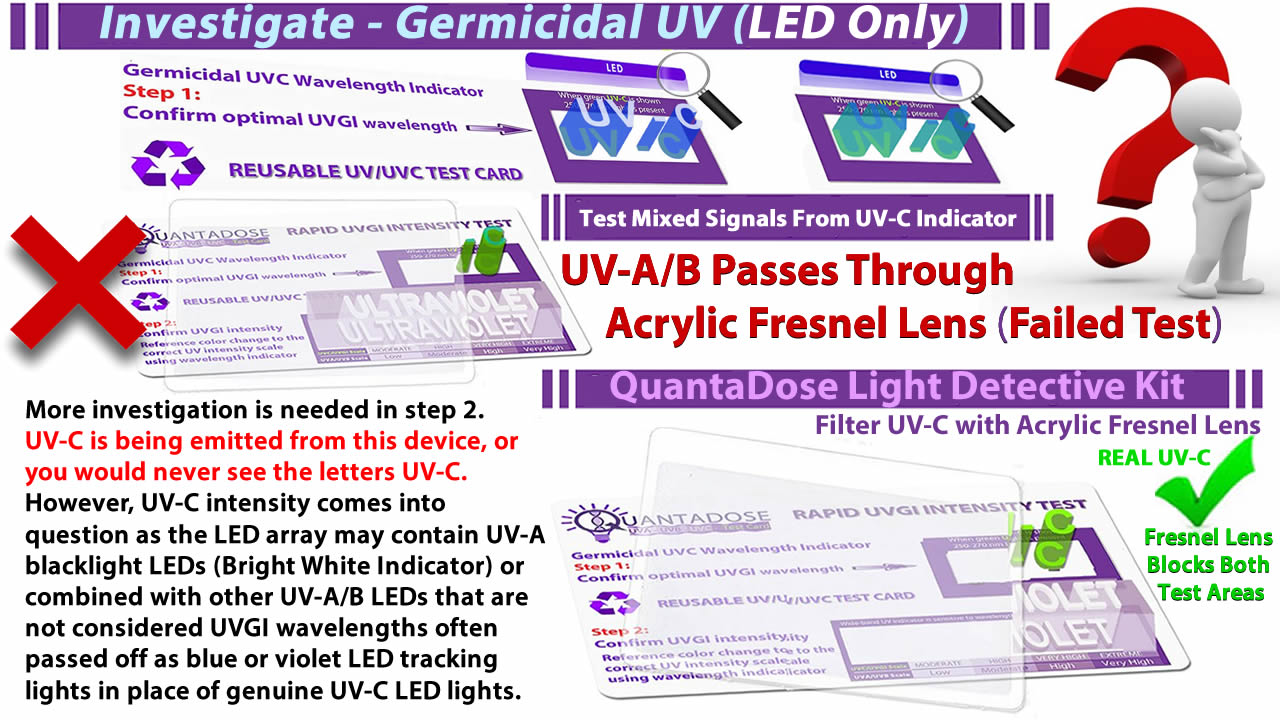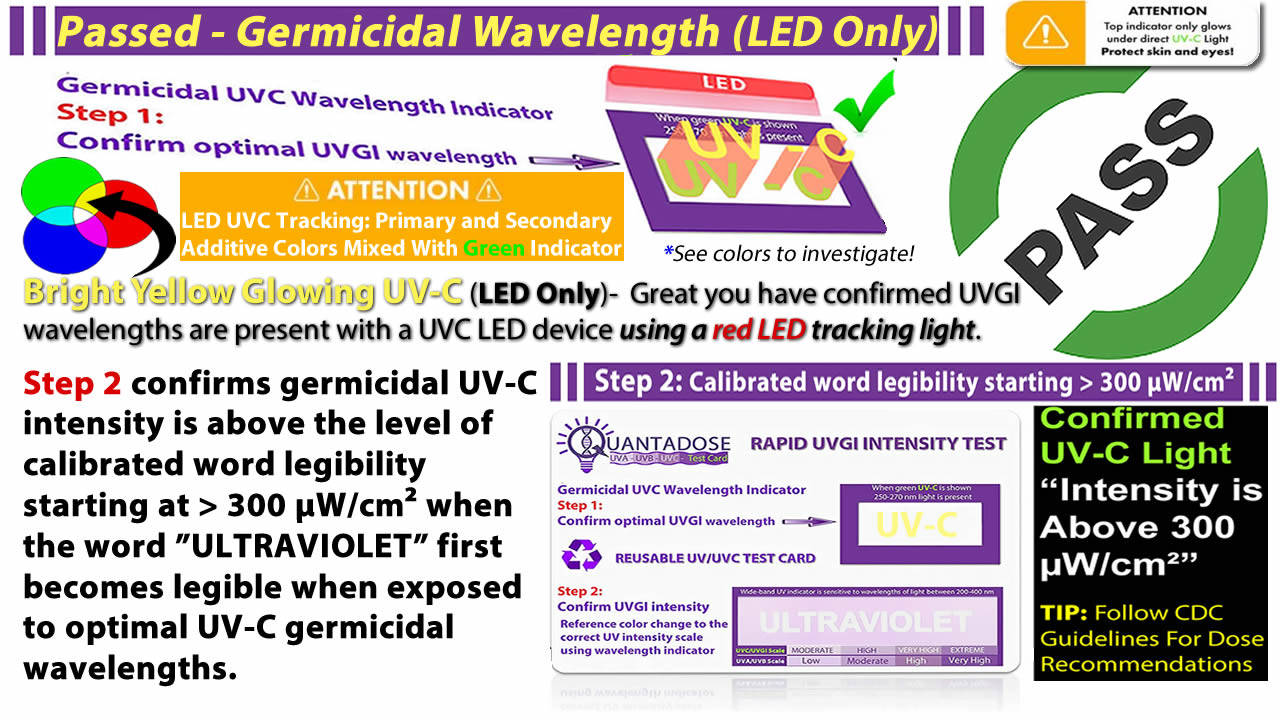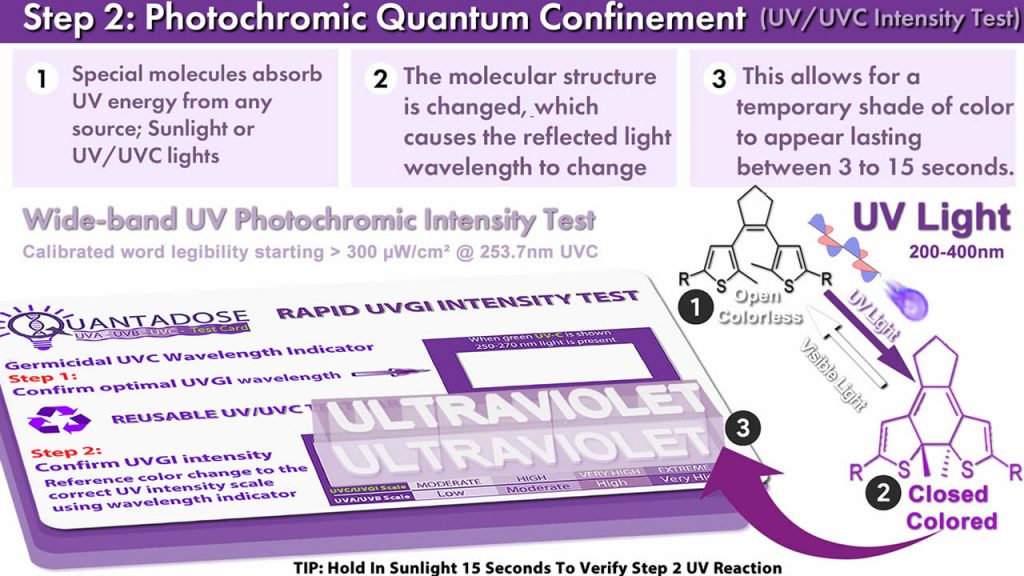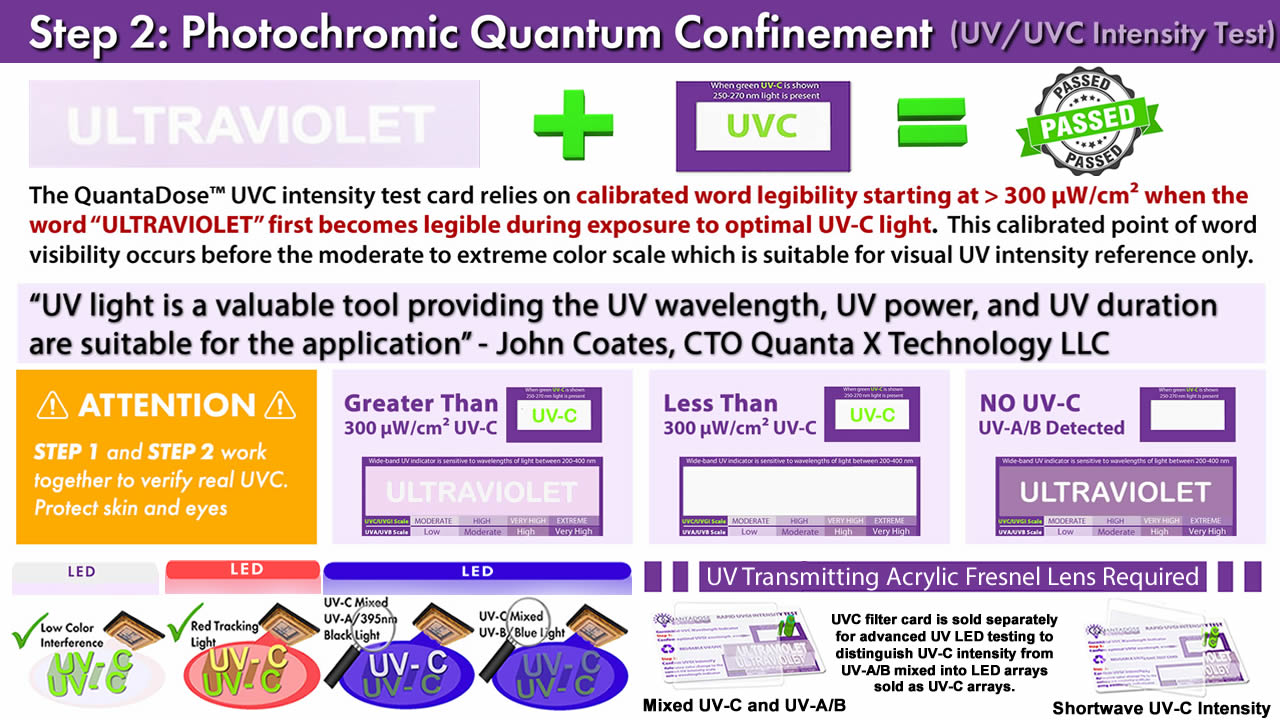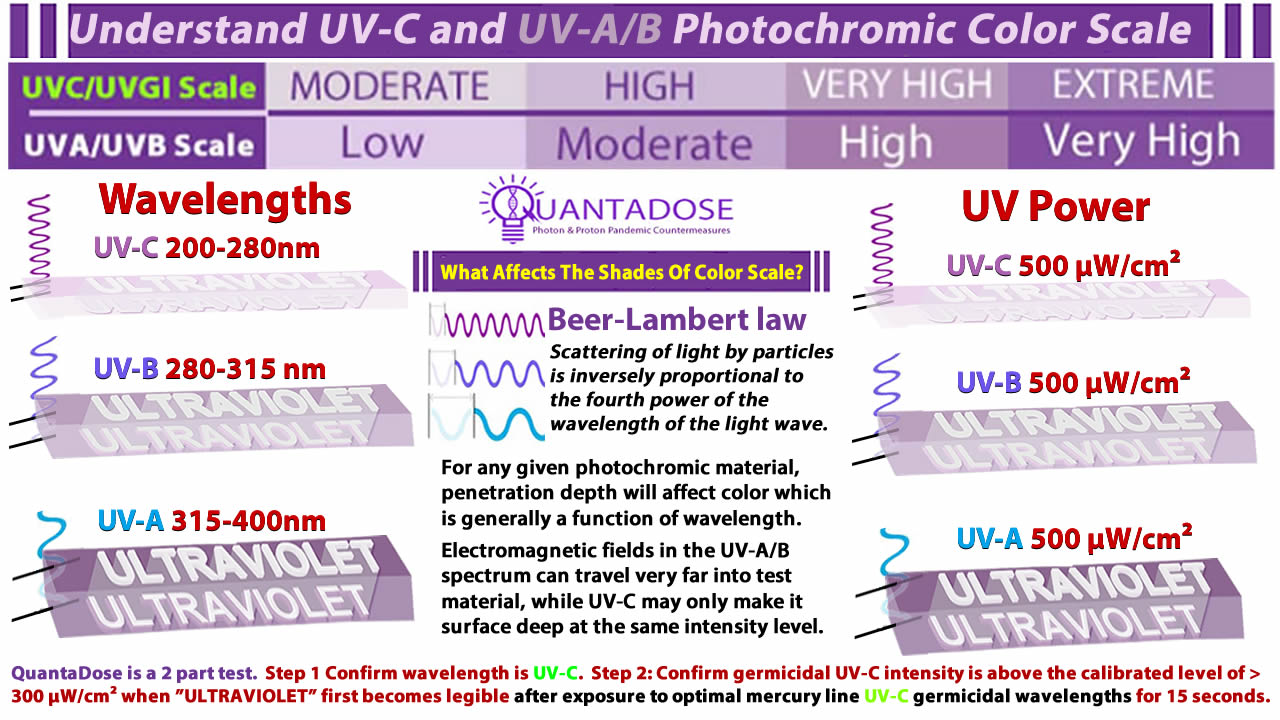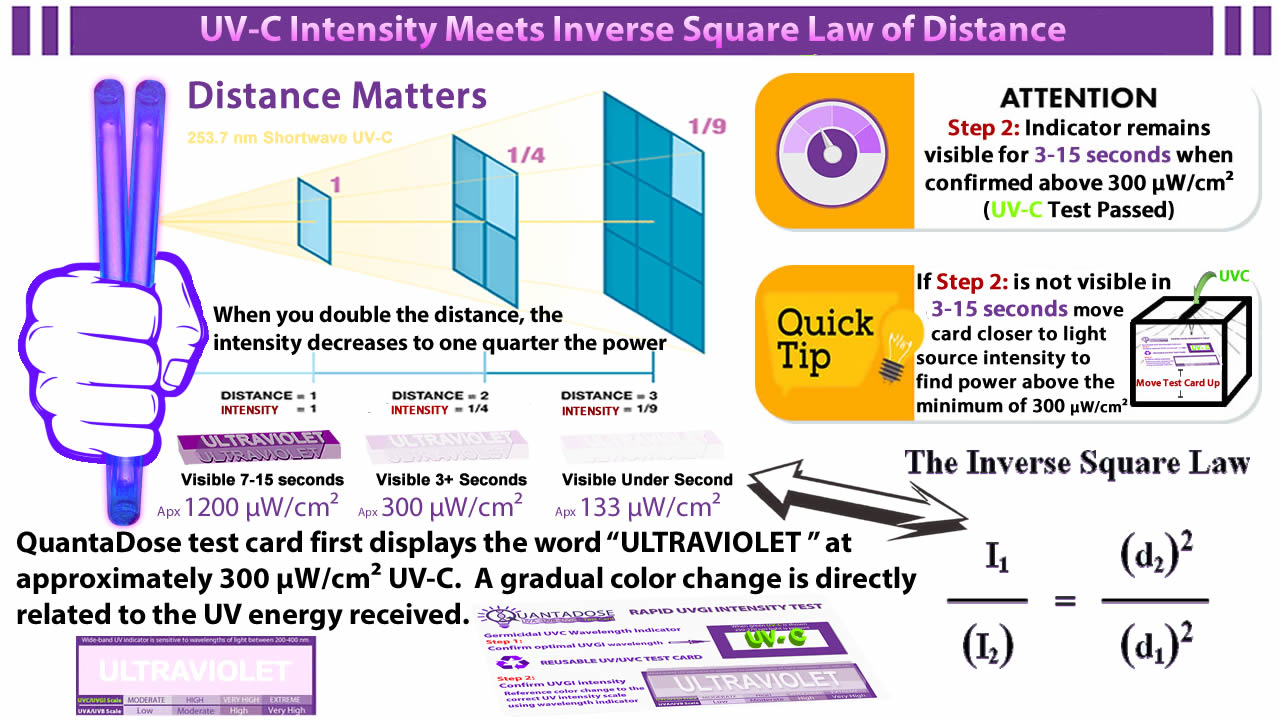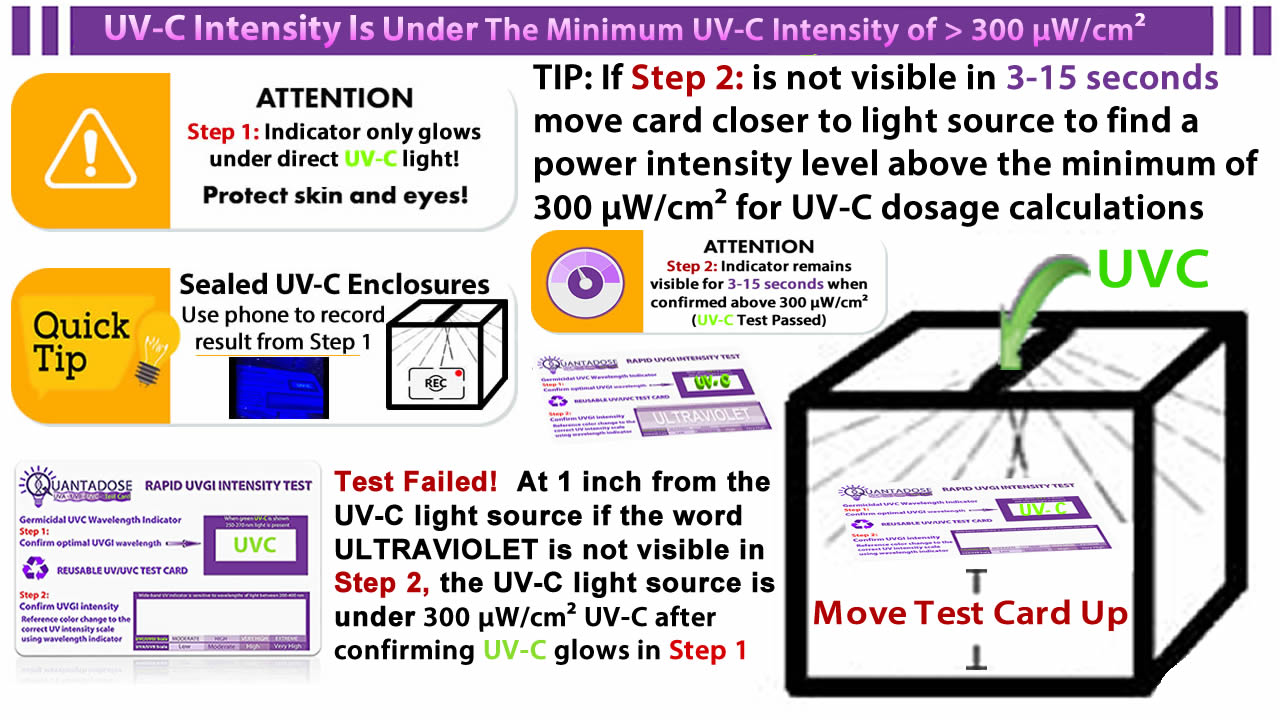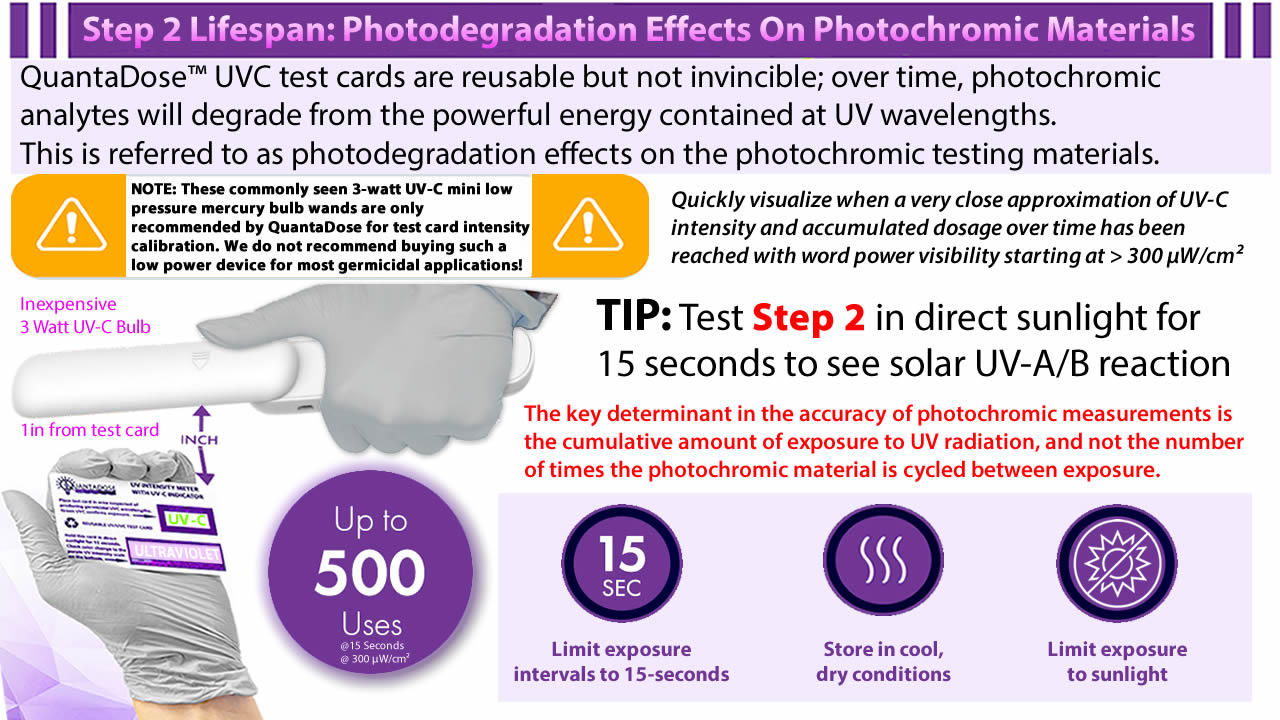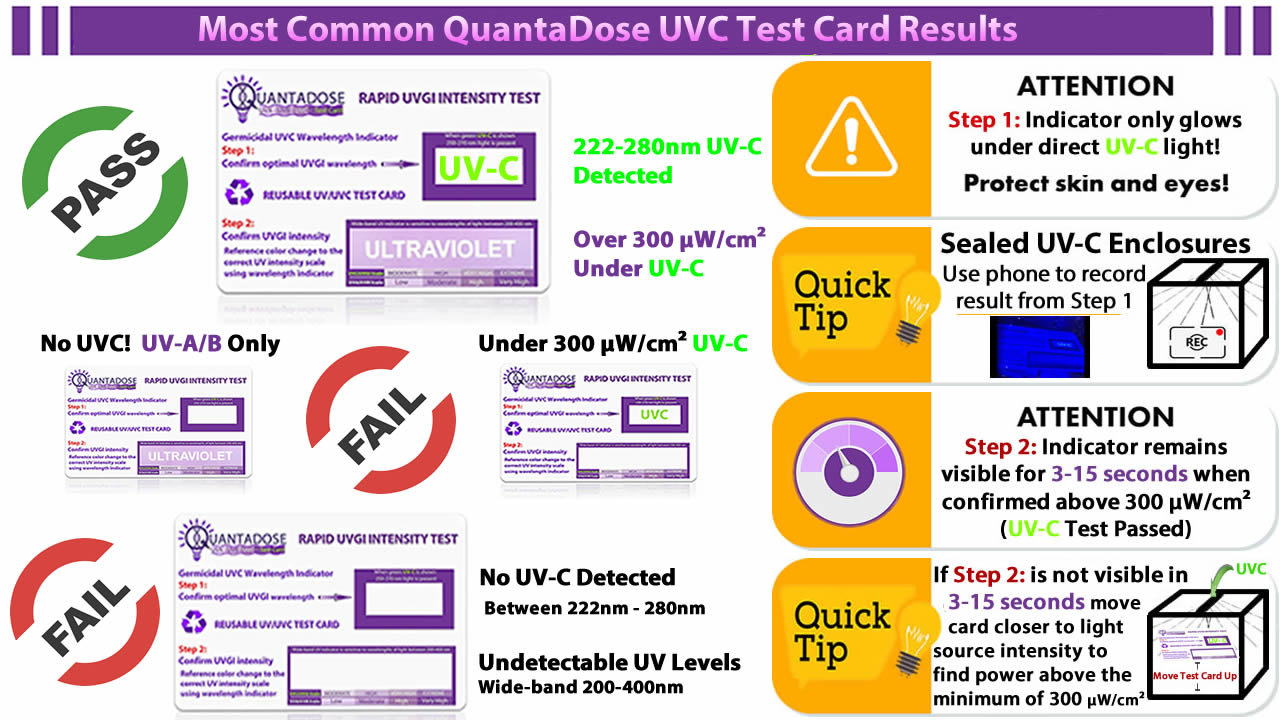QuantaDose Press Releases
UV-C Test Results Flow Chart – QuantaDose UV-C Test Card is a Two-part UV Test Card
The QuantaDose UV-C test card is a two-part UV test card.
Step 1 Introduction:
Step 1 confirms UV-C wavelengths by glowing green only when exposed to invisible UV-C light between 222-280nm. Confirming the wavelength indicator in Step 1 is necessary to ensure the intensity measurement in Step 2 measures intensity levels from scientifically established UVGI (Ultraviolet Germicidal Irradiation) Ultraviolet-C and not UV-A/B wavelengths.
The out-right FAIL! NO UVC Detected!
The above UVC test card image on the left shows the QuantaDose is not detecting UVC or UV. The image on the right detected only UV-A/B without detecting germicidal light between 222-280nm in the UV-C spectrum. Both example results above are to be considered a falsely advertised UVGI light source.
PASS! UVC is detected without any interference from non-UVGI wavelengths or added colors of light used for tracking invisible UV light being emitted. This provides the expected visual result of 515nm green light being emitted from the letters UV-C. The green result is confined to the physical shape and size of the molecular structure of the material.
Results: Step 1 When the specialized narrow-band shortwave analyte absorbs invisible UV-C light between 222-280 nm, the top indicator emits photons at a wavelength interval of approximately 515 nm or a frequency interval of around 590 THz from the letters UV-C in the visible light spectrum causing the letters UV-C to illuminate in bright green glowing fluorescent color.
| green | ~ 500–565 nm | ~ 600–530 THz |
|---|
The Step 1 result with all genuine properly functioning UV-C Mercury Bulbs, Excimer Lamps, and Microcavity Plasma Bulbs will ALWAYS display a bright green because the visible spectrum of interference is limited to a maximum of 15% of the UV-C bulb’s total output power.
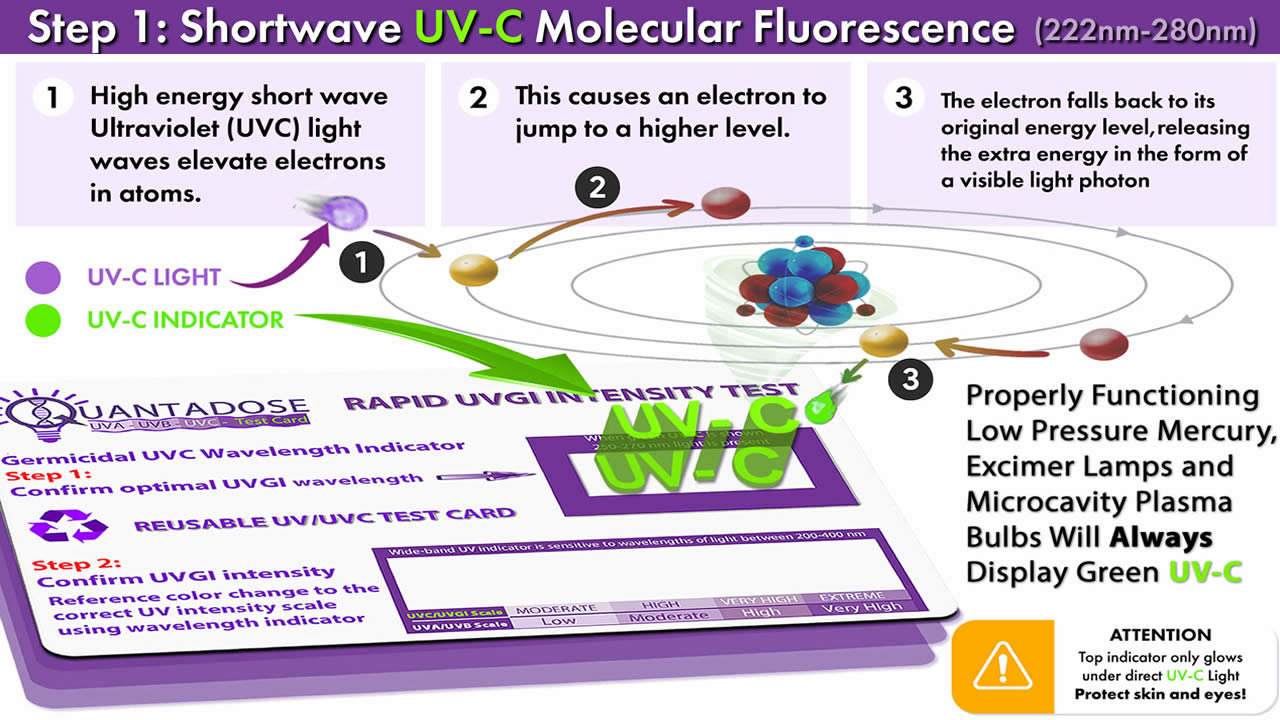
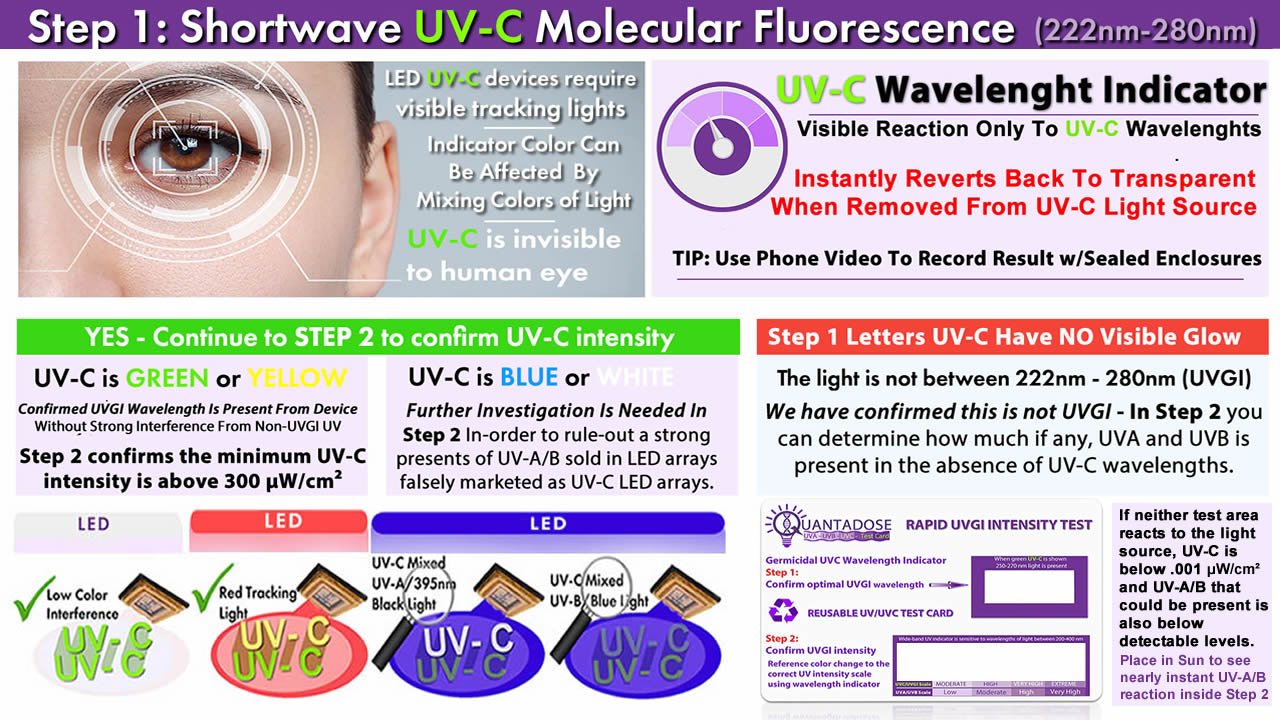
The color that Step 1 emits is relative only to photons at a wavelength of 515nm. Therefore it is always green if it can be seen, however just like mixing colors of paint, mixing colors of light as these photons reach your eyes will change the original color’s perception.
UV-C is invisible, so a visual indicator light is needed for UV-C LED product safety. The intentional mixing of light colors and weaker forms of UV (A/B) light only occurs when testing UV-C LED light sources.
Less reputable companies selling imported devices will try to hide UV-C LED underperformance by adding several much cheaper UV-A/B LEDs into an array sold as a germicidal UV-C array. This deception is often disguised conveniently as blue and violet UV-C tracking LEDs.
The most reputable UV-C LED light manufactures in the USA will use a red LED tracking color, a color wavelength that can’t be confused with UV output power in germicidal lighting applications. The color red has the longest visible light waves, while purple (violet) has the shortest waves closest to UV backlights. Manufactures using red LED tracking lights for their UVC LED lights to take a nothing to hide approach that we at QuantaDose applaud!
The QuantaDose informs you when you reach a certain UV-C level to make dose calculations. It also informs you of what other non-germicidal UV wavelengths are mixed in the UV-C light device you are testing. Differentiating UV-C power intensity from UV-A/B power intensity can be done in seconds using a simple fresnel acrylic lens (UV-C filter) card explained in Step 2 for advanced UV-C LED fraud detection testing with the QuantaDose card.
RECAP: UNDERSTANDING STEP 1 TEST PROCEDURE AND RESULTS
Step 1: What happened when QuantaDose UVC Test Card was placed directly under a light source? (Instant Result)
Results: Step 1 When exposed to invisible UV-C light between 222-280 nm, the top indicator emits photons at a wavelength interval of approximately 515 nm or a frequency interval of around 590 THz from the letters UV-C in the visible light spectrum causing the letters UV-C to illuminate in bright green glowing fluorescent color.
1: No Reaction (Bulb or LED) – The light source does not emit a germicidal wavelength between 222-280 nm!
WHAT TO DO: Continue to step 2 to see if non-germicidal UV is present in the UV-A/B wavelengths.
2: Bright Green Glowing UV-C (Bulb or LED) – Great you have confirmed UVGI wavelengths are present!
WHAT TO DO: Continue to step 2 to confirm germicidal UV-C intensity is above the calibrated word legibility starting > 300 µW/cm² when the word ” ULTRAVIOLET” first becomes legible exposed to optimal UV-C germicidal wavelengths.
3: Bright Yellow Glowing UV-C (LED Only)- Great you have confirmed UVGI wavelengths are present with a UVC LED device using a red LED tracking light.
WHAT TO DO: Continue to step 2 to confirm germicidal UV-C intensity is above the calibrated word legibility starting > 300 µW/cm² when the word ” ULTRAVIOLET” first becomes legible exposed to optimal UV-C germicidal wavelengths.
4: Bright White/Blue UV-C Letters with Strong Blue Hue (LED Only)
More investigation is needed in step 2. UV-C is being emitted from this device, or you would never see the letters UV-C. However, UV-C intensity comes into question as the LED array may contain UV-A blacklight LEDs (Bright White Indicator) or combined with other UV-A/B LEDs that are not considered UVGI wavelengths often passed off as blue or violet LED tracking lights in place of genuine UV-C LEDs
WHAT TO DO: Use a QuantaDose credit card-sized Visible Light Magnifying UVC Filter. The 4 pc QuantaDose Light Detective Kit ( 2 x QuantaDose cards, 1 x Magnifying UVC Filter (UV Transmitting Acrylic Fresnel Lens), 1 x UV proof Mylar storage bag) This takes your UV-C investigation into invisible light a step further to answer your questions about UV-A/B LEDs being mixed in with UV-C LEDs. The QuantaDose Light Detective Kit includes a credit card-sized magnifying card made from a plastic suitable for filtering UV-C light while allowing all visible light and UV-A and UV-B to easily pass through the lens. When used combined with the QuantaDose UVC test card, step 2 provides even more information about the light source you are testing.
All intensity time-dosage calculations must be done based on the conformation of UV-C in Step 1 and calibrated > 300 µW/cm² legibility of the word ”ULTRAVIOLET” in Step 2.
Step 2 Introduction:
What happens when QuantaDose UVC Test Card is placed directly under a UV-C light source for 15 seconds with a power intensity level greater than > 300 µW/cm²?

Step 2 uses a very wide-band photochromic test area that relies on calibrated word legibility starting > 300 µW/cm² when the word ” ULTRAVIOLET” first becomes legible exposed to optimal UV-C germicidal wavelengths.
The Step 2 intensity color scale is for visual reference only for increased or decreased power levels. When filtering wavelengths in the final steps of UV-C LED array testing, it is most helpful to detect UVA and UVB intensity over UV-C when arrayed with a mixture of long and shortwave UV LEDs on the same device. The color differential scale is important in this stage of testing intensity levels from different UV wavelengths from the same device.
Most Common Results
NO UVA/UVB or UVC DETECTED
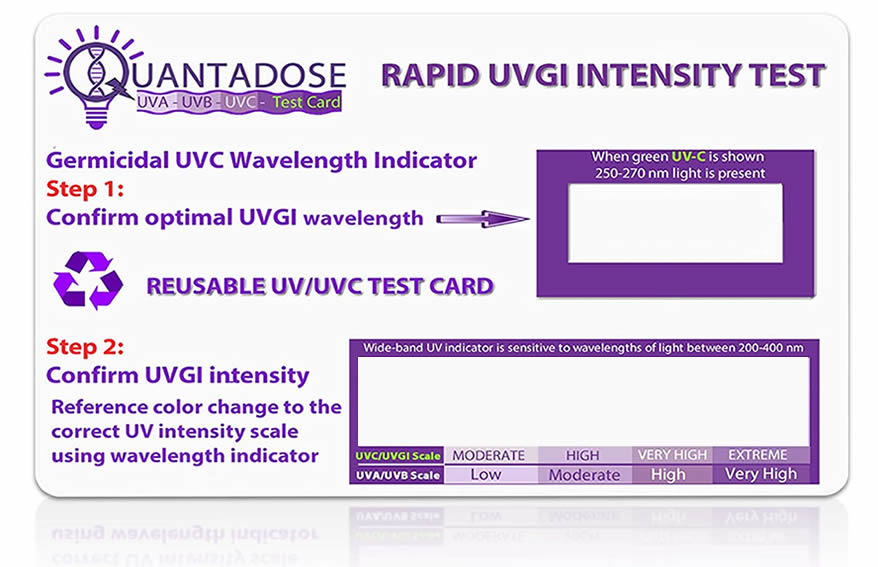
UVA/UVB DETECTED – NO UVC DETECTED!
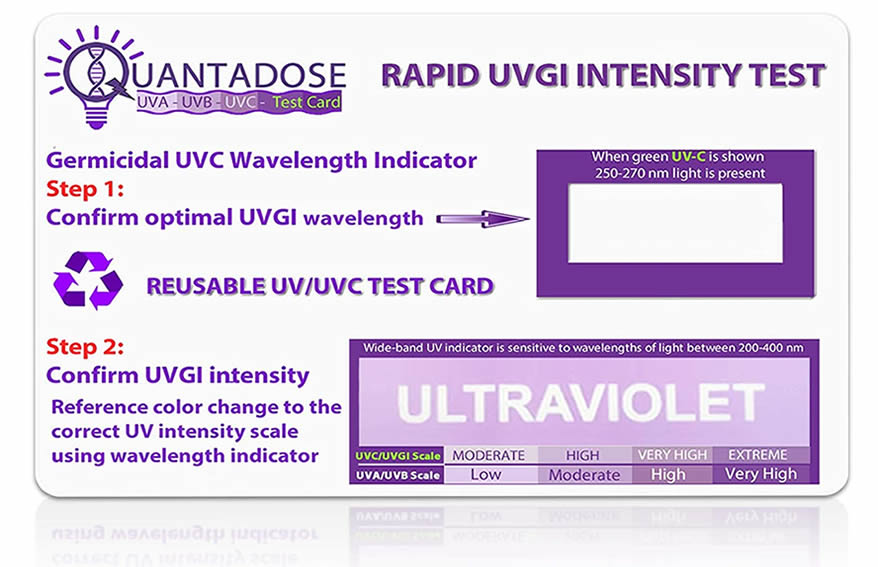
UV-C DETECTED – NO UVA/UVB DETECTED, or UVC is < 300 µW/cm², so the word ” ULTRAVIOLET” is not legible
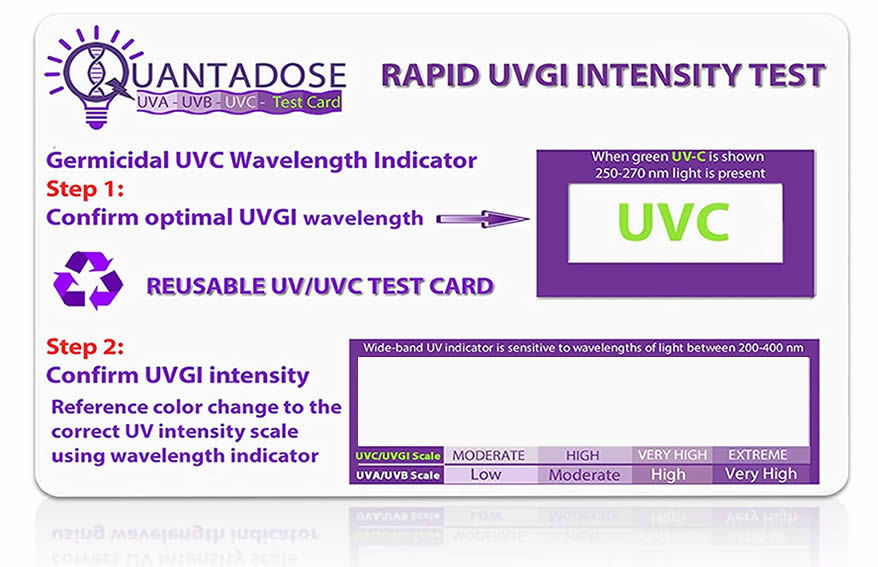
PASSED > 300 µW/cm² UV-C DETECTED!
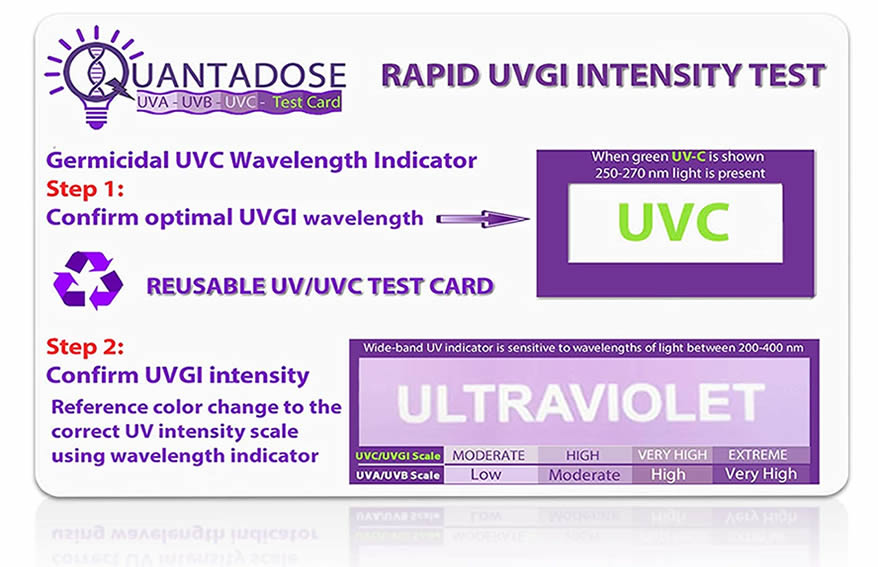
QuantaDose Summarized Testing and Results
